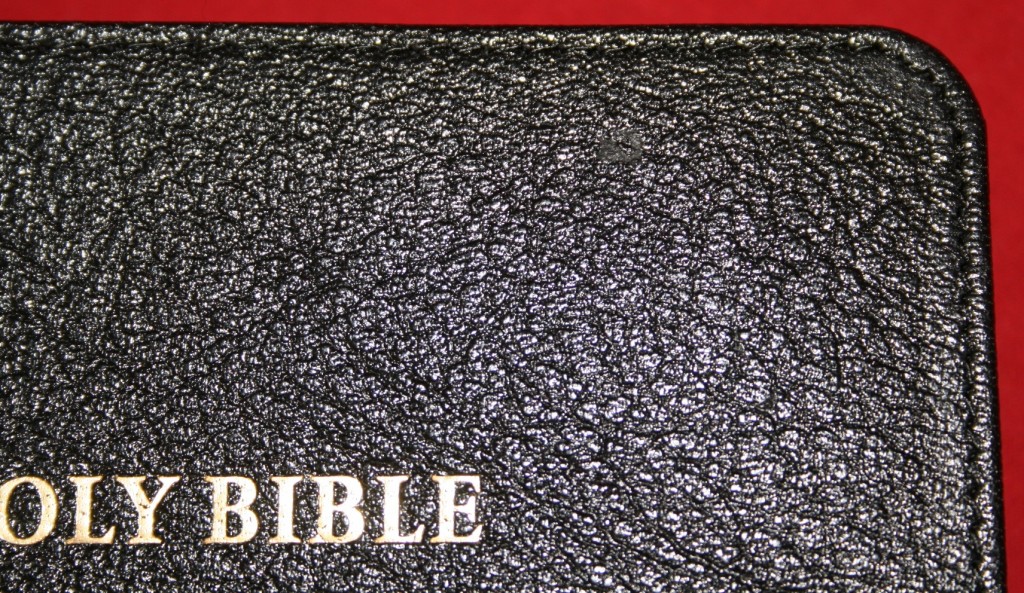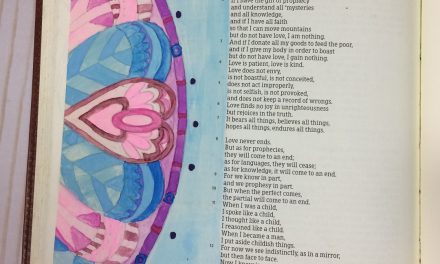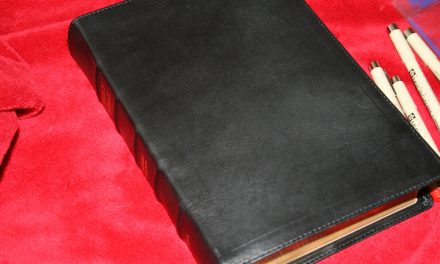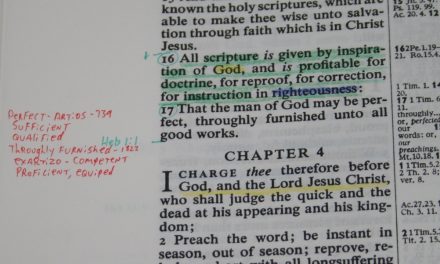The cover of the Bible is a very important feature and should be chosen carefully. I recommend buying the best cover you can afford. A badly made cover will greatly shorten the life of the Bible, whereas a Bible with a high quality cover has a better chance of lasting a life-time. Here is a short glossary of Bible cover terms.
Smyth Sewn – also known as ‘Section Sewn’. This is the highest quality book-binding available. It is library quality and archival safe. The pages are physically sewn together in sections, known as signatures, using binders thread. Usually around 24 pages, the signatures are folded over to make individual sections of the book. The sections are then sewn together, creating the text block. The text block is then glued into the cover using a fabric backing, imitation leather, bonded leather, or real leather.
Genuine Leather – pigskin. This is the cheapest and most popular of real leathers.
Berkshire – pigskin. Another term for Genuine Leather.
Bonded Leather – chopped ham. Left-over leather pieces are glued together using glues and resins to form a leather-like cover. In general, bonded leathers will not last. They tear apart under regular use. Like all leathers, there are various qualities of bonded leather. Cambridge uses 100% real leather fiber. Cambridge bonded leathers will outlast some genuine leathers.
Calfskin – a higher quality leather used for fine bindings. It is usually soft and flexible, which increases with use.
Goatskin – Goatskin and Highland Goatskin (also known as Real Morocco, or simply Morocco) have a natural grain. All other leathers have a grain that is stamped onto the leather. Goatskin is very durable and soft.
French Morocco – taken from calfskin. Durable and flexible, though not as soft and flexible as calfskin, it is still a high-quality leather. It is an economical alternative to calfskin.
Imitation Leather – imitation leather is a man-made material that is made to look and feel like leather. There are many variations of imitation leather and they have different names such as Kirvella and Leatherflex. Usually, the higher quality imitation leathers will look and feel soft and be very durable. The cheaper imitation leathers will feel like tough plastic.
Hardcover – hardcover Bibles are made like any other hardcover book. This is one of the cheapest covers (the cheapest is paperback). Hardcover Bibles are not usually made with the same quality bindings as leather-bound covers. Hardcover is a great alternative when buying study Bibles for your library that will not be used as your primary carry Bible.
Lining – the lining is the material on the inside of the cover. It ranges from paper to calfskin leather. Many Bibles use bonded leather or imitation leather for the lining, but there are some Bibles that have real leather.
Yapp – this is the leather that goes beyond the edge of the pages. It is available as full Yapp and semi Yapp.
Overcasting – This is vertical stitching that is inserted at the middle of the first and last section to add strength to the binding. Overcasting is found in higher quality Bibles.












This is good information to have. I have been extremely disappointed in the bonded leather of some of my Bibles. I have a NIV I bought little more than a year ago, and with frequent use the surface is already peeling along the spine. I have been much happier with a tru-tone cover on an ESV I have had for a couple years. It’s as nice as the day I got it, and feels like calfskin. I have only one genuine leather covered Bible, a NASB MacArthur SB, and though it’s several years old, it’s perfect.
Dear Randy:
Covers and binding on Bibles are not always selected for the use the particular Bible is put to, this is I think unfortunate. I think we all admire the appearance and soft supple feel of Highland Goatskin. Unfortunately Goatskin is not always the best choice. Besides the additional cost, the very qualities that make it attractive, make it less than well suited to certain uses. If for instance the Bible is to be used while seated in a favorite easy chair handheld, that soft supple cover will not support the text block as well as the less highly regarded and less expensive French Morocco, or even a hard binding. This is especially important if the text block is large like the Thompson Chain Reference Bible. It is often the less expensive cover that serves the reader best. One should consider the use the Bible is put to before selecting the cover. Often one selects a Bible for public carry and wants one that instills pride of ownership. There is nothing wrong in selecting a beautiful Bible one can be proud of, I do suggest though that the use it will be put to should be considered as well. I have found Calfskin, French Morocco, and other less expensive covers both attractive, and better support for the text block (unless it is Bonded Leather), providing easier one handed reading whether standing or seated than the beautiful and expensive Highland Goatskin. I recently purchased the LCBP Thompson Chain Reference Bible for instance, it is a lovely well made Bible. It was available only in Ironed Calfskin, a wonderful, soft textured, thin and beautiful material. The problem is, that it is difficult to use seated or standing handheld for more than a few minutes, the Ironed Calfskin just doesn’t support the large text block well enough to protect it, it would be better suited to a smaller Bible. I am sure we all have seen Bibles with the bottom edges of the cover and the pages damaged and worn away and with the ribbons worn to the edge of the pages, a firmer cover would have protected the text block of these Bibles better. I am considering getting My LCBP Thompson rebound in a firmer cover, something like French Morocco because of this. I am sure that others will have no problems with this cover due to the way they use their Bibles. The bottom line is this, consider the use the Bible is going to be put to before selecting the cover or type of binding. It is possible that the best cover for some uses would be hard bound, leather covered or not. I think though that we should all regard Bonded Leather as leather fiber and glue based cardboard.
Yours in Christ
Don